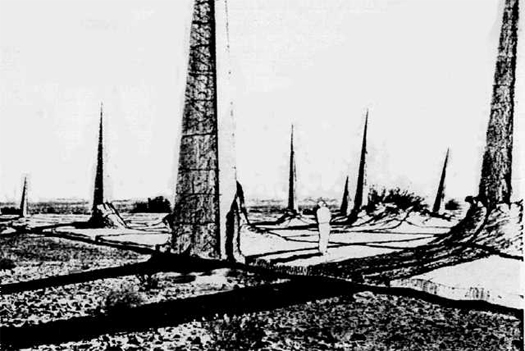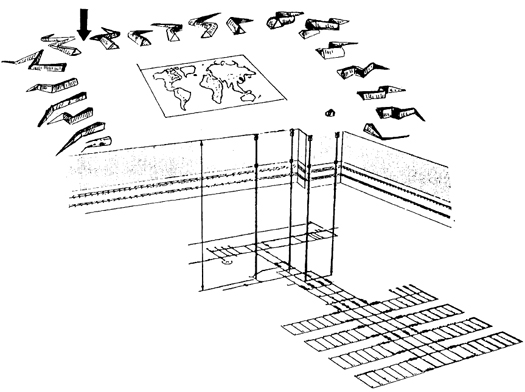
[“Landscape of Thorns”, concept by Michael Brill and drawing by Safdar Abidi, from Marking the Waste Isolation Pilot Plant for 10,000 Years]
Triggered by the recent revelation that tests at the Pacific Northwest National Laboratory reveal that a seemingly innocuous white substance filling a glass bottle dug up in 2004 is actually “the oldest existing sample of bomb-grade plutonium from a nuclear reactor, with a half-life of 24,110 years,” Juliet Lapidos reviews the Department of Energy’s 1993 recommendations for the construction of a massive nuclear-waste disposal warning landscape. The trouble, of course, is that anything one does to communicate danger is likely to also communicate mystery and excitement to future treasure-hunters or archaeologists:
The report’s proposed solution is a layered message—one that conveys not only that the site is dangerous but that there’s a legitimate (nonsuperstitious) reason to think so. It should also emphasize that there’s no buried treasure, just toxic trash. Here’s how the authors phrase the essential talking points: “[T]his place is not a place of honor … no highly esteemed deed is commemorated here.” Finally, the marker system should communicate that the danger—an emanation of energy—is unleashed only if you disturb the place physically, so it’s best left uninhabited.
As for the problem of actually getting these essentials across, the report proposes a system of redundancy—a fancy way of saying throw everything at the wall and hope that something sticks. Giant, jagged earthwork berms should surround the area. Dozens of granite message walls or kiosks, each 25 feet high, might present graphic images of human faces contorted with horror, terror, or pain (the inspiration here is Edvard Munch’s Scream) as well as text in English, Spanish, Russian, French, Chinese, Arabic, and Navajo explaining what’s buried. This variety of languages, as Charles Piller remarked in a 2006 Los Angeles Times story, turns the monoliths into quasi-Rosetta stones. Three rooms—one off-site but nearby, one centrally located, and one underground—would serve as information centers with more detailed explanations of nuclear waste and its hazards, maps showing the location of similar sites around the world, and star charts to help intruders calculate the year the site was sealed…
Proposals for the “earthworks” component demonstrate that the whole project of communicating with the future is really a creative assignment, more dependent on the imagination than on expertise… The report proposes a “Landscape of Thorns” with giant obelisklike stones sticking out of the earth at odd angles. “Menacing Earthworks” has lightning-shaped mounds radiating out of a square. In “Forbidding Blocks,” a Lego city gone terribly wrong, black, irregular stones “are set in a grid, defining a square, with 5-foot wide ‘streets’ running both ways. You can even get ‘in’ it, but the streets lead nowhere, and they are too narrow to live in, farm in, or even meet in.”

The full report, Expert Judgment on Markers To Deter Inadvertent Human Intrusion Into the Waste Isolation Pilot Plant, is, as Lapidos notes, a “bizarrely fascinating read”, with the last two appendices, in particular, reading like summary notes from some intensely strange landscape architecture studio, filled with durability comparisons between concrete monoliths and Egyptian pyramids, poetic denunciations of the buried wastes (“What is here was dangerous and repulsive to us…”), suggestions that the waste site be constructed in the form of a massive global map of similar nuclear waste repositories, geologic cross-sections of the repository, fictionalized accounts of the arrival of explorers on the site in some distant future, and even the suggestion that the site be carved into massive “Aeolian structures”, noting that “sounds that can readily be generated by long-lasting aeolian structures turn out often to be dissonant and mournful”, neatly lining up with the general atmosphere of “great foreboding” to be produced. The description of the proposed “Black Hole” is typical:
A masonry slab, either of black Basalt rock, or black-dyed concrete, is an image of an enormous black hole; an immense nothing; a void; land removed from use with nothing left behind; a useless place. It both looks uninhabitable and unfarmable, and it is, for it is exceedingly hot part of the year. Its blackness absorbs the desert’s high sun-heat load and radiates it back. It is a massive effort to make a place that is fearful, ugly, and uncomfortable. The heat of this black slab will generate substantial thermal movement. It should have thick expansion joints in a pattern that is irregular, like a crazy-quilt, like the cracks in parched land. And the surface of the slab should undulate, so as to shed sand in patterns in the direction of the wind.

One could easily imagine some future Severian, wandering his future Urth, encountering these constructed waste-fields but as blissfully unaware of their intended warnings as he is that the dungeon-like tower he was raised in was once the launch complex of a vast spaceport. But even if you could design a landscape so obviously “fearful, ugly, and uncomfortable” as to disquiet this imaginary Severian, you still encounter the crux of the problem: how do you design a landscape which is universally repulsive, without attracting those who are fascinated by repulsive landscapes?
[Edible Geography and BLDGBLOG’s recent interview with Department of Energy scientist Abraham Van Luik briefly touches on the WIPP, and should be of interest if you’ve read to the end of this post]


I ran across a topical RIBA President’s Medal nomination in a fortuitous “random entry” search:
http://www.presidentsmedals.com/Project_Details.aspx?id=2366&dop=True&year=2009
Eternally Yours : Human[Ity] Shield by Claire Jamieson of the Royal College of Art
Topical indeed, with a diametrically opposite approach.
what does france do with its waste? they get most of their energy from nuclear. can’t it be refined? seems like an awesome landscape, but unnecessary. i was struck by how over-the-top the whole project seemed when reading bldg blog’s discussion with the guy from the dept. of energy. Stewart brand characterizes the whole project as the essentially the bastard love-child of nimby-ism and cold war paranoia.
faslanyc:
what does france do with its waste?
Rob had a great post on this topic a while back, near the beginning of the life of this blog: http://m.ammoth.us/blog/2009/04/the-most-sublime-room-in-the-world/
great tip, nice piece. love me some beth myer. any idea why we are going to such great lengths, whereas the french handle the issue differently, seemingly more pragmatically? I question our policy, after reading stewart brand.
I think that there’s little doubt that the French attitude — recycling spent fuel as much as possible — is better than our “one-and-done” attitude, but while it massively reduces the amount of final waste produced (this article suggests a potential 100-fold reduction, though that relies on technology that hasn’t been implemented yet), recycling still doesn’t eliminate the need to store nuclear waste on a geological time scale. Which isn’t to endorse the WIPP approach; I blogged it because I thought it was interesting, not right.
Simultaneous posting… technological and political reasons, both, I think.
Politically, from the article in my last comment: “The United States officially banned reprocessing of spent fuel for power reactors in 1977, during the administration of President Jimmy Carter, who feared that proliferation of reprocessing technology would make it too easy for wayward nations or even terrorist groups to obtain the raw material for bombs.”
Technologically, I can’t say I really understand the problem, but it has something to do with “breeder reactors”, which would use reprocessed fuel more efficiently, but haven’t been implemented successfully on a commercial scale yet.
an interesting post on places today regarding this topic and cities in the mojave desert in general.
http://places.designobserver.com/entry.html?entry=10807#comments
The John Beck quote about the significance of the desert in judeo-christian tradition is especially poignant. I like the thought of Las Vegas and its surrounds as alternately an “escape from modernity, an elemental alternative to the rational order of ‘civilized’ life,” and “the chaos of an unordered primal ‘nature’ that must be resisted and expunged. . . .” which they go on to expound upon a bit in an interesting way.
check this out- http://thoriumenergy.blogspot.com/
just recently profiled in wired.
[…] and quarantine economies), as well as two posts more generally related to matters of quarantine (this place is best shunned and left uninhabited, on designing the landscape of nuclear waste repositories, and pueraria lobata, on invasive […]
[…] post on ways of making nuclear waste sites recognisably dangerous over long periods of time – this place is best shunned and left uninhabited. Triggered by the recent revelation that tests at the Pacific Northwest National Laboratory reveal […]
[…] post on ways of making nuclear waste sites recognisably dangerous over long periods of time – this place is best shunned and left uninhabited. Triggered by the recent revelation that tests at the Pacific Northwest National Laboratory reveal […]